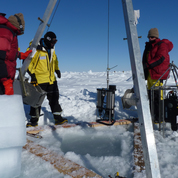Primary Productivity Monitoring In The Antarctic
Marine photosynthesis is responsible for approximately half the oxygen in our atmosphere. In other words the oxygen in every second breath we take comes from the ocean

For the last 10 years Professor Andrew McMinn and his team from the Institute for Marine and Antarctic Studies, University of Tasmania have been using a Chelsea FastOcean Fast Repetition Rate fluorometer (FRRf) to gain an insight into primary production, photosynthesis and photosynthetic health in the Southern Ocean and Antarctic.
His most recent deployments unearthed some new and interesting results relating to the physiological adaptations of Antarctic phytoplankton surviving in almost complete darkness under the East Antarctic sea ice.
The growth and retreat of Antarctic sea ice is the greatest seasonal cycle on Earth, and one that has a profound influence on the organisms that live in the region. Professor McMinn’s interest is in the very base of the food chain, the phytoplankton and single celled algae that are the foundation for the whole Antarctic ecosystem.
Phytoplankton photosynthesize and produce oxygen just like the trees and land plants you see around you everyday. Marine photosynthesis is responsible for approximately half the oxygen in our atmosphere. Changes in sea ice extent and thickness will have massive affects on the phytoplankton and algae in the Southern Ocean and Antarctic regions.
Professor McMinn’s interest is in investigating how these changes will play out and how they will influence these extremely important photosynthetic organisms we rely so much on.
Professor McMinn and his team own a number of Chelsea FRR fluorometers. These are deployed from ships (usually large icebreakers) in vertical profiling mode, usually along side CTDs, and in an underway flow through set ups. On their most recent mission the FastOcean ADP Profiling System was deployed through a hole in the sea ice and lowered by hand using a tripod and winches (see photo above).
"The main challenge we face during our regular deployments in the Antarctic," said Professor McMinn "is working in temperatures below -30°C. These conditions are particularly tough on electronic equipment but we were pleasantly surprised with the performance of the FastOcean on our recent Antarctic expedition. The only difficulty, aside from reduced battery life that occurs with all devices in the cold, we experienced with the FastOcean was freezing of the externally mounted dark chamber and pump. This was overcome by pre-heating super saline water and filling the chamber, hosing and pump with this liquid prior to deployment. Once the instrument was in the water the pump behaved normally."
When asked why he choose a Chelsea FRRf, Professor Minns said: “Chelsea is one of the only manufacturers of Fast Repetition Rate Fluorometers and we have many years experience using pervious versions of the FastOcean instruments, so when it came time to replace our instruments the FastOcean was a logical choice.
"We are still using two older versions of the FastOcean. We currently have two Mk I instruments dedicated to long-term international monitoring programs. One is permanently deployed on a Japanese icebreaker and the other on a French icebreaker. These instruments have each done many thousands of hours service and are still performing extremely well. The older of our two instruments has been in service for more than 10 consecutive years. We typically deploy the FastOcean for several months at a time on long Antarctic research voyages.
These expeditions usually occur several times a year and when the instruments are not out on these missions they are used in lab based or local field studies back in Australia.”
CONTACT
Ellen Keegan
Chelsea Technologies Group Ltd
ekeegan@chelsea.co.uk
www.chelsea.co.uk
+44 (0) 20 8481 9000
Tuesday 18 June 2013 / file under Environmental | Technology



